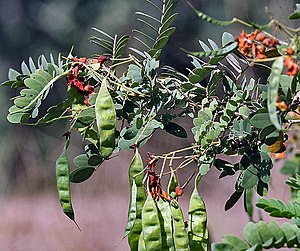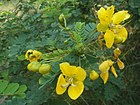Note: This is a project under development. The articles on this wiki are just being initiated and broadly incomplete. You can Help creating new pages.
Difference between revisions of "Senna auriculata - Avaram senna"
(→External Links) |
|||
| (31 intermediate revisions by one other user not shown) | |||
| Line 1: | Line 1: | ||
[[File:Ranawara or Avaram- Senna auriculata at Sindhrot near Vadodara, Gujrat Pix 047.jpg|thumb|right|''Senna auriculata'', ''Avarike'']] | [[File:Ranawara or Avaram- Senna auriculata at Sindhrot near Vadodara, Gujrat Pix 047.jpg|thumb|right|''Senna auriculata'', ''Avarike'']] | ||
| − | + | '''Senna auriculata''' is a legume tree in the subfamily Caesalpinioideae. It is commonly known by its local names '''matura tea tree, ranawara''' or '''avaram'''. | |
| − | '''Senna auriculata''' is a legume tree in the subfamily Caesalpinioideae. It is commonly known by its local names '''matura tea tree, ranawara''' or '''avaram''' | ||
| − | |||
| − | |||
==Uses== | ==Uses== | ||
| − | {{Uses| | + | {{Uses|Rheumatism}}, {{Uses|Eye diseases}}, {{Uses|Gonorrhea}}, {{Uses|Diabetes}}, {{Uses|Gout}}. |
==Parts Used== | ==Parts Used== | ||
| − | {{Parts Used| | + | {{Parts Used|Roots}}, {{Parts Used|Bark}}, {{Parts Used|Leaves}}. |
==Chemical Composition== | ==Chemical Composition== | ||
| − | + | Seed contains anthraquinones,namely;(aurantio-obtusin, chryso-obtusin,obtusin, chrysoobtusin, beta glucoside, physcion, emodin, chrysophanol, obtusifolin, obtusifolin-2-O-beta-D-glucoside, alaternin 2-O-β-Dglucopyranoside)15, brassinosteroids(brassinolide, castasterone, typhasterol,teasterone.<ref name="chemical composition"/> | |
==Common names== | ==Common names== | ||
| − | {{Common names|kn=|ml=|sa=|ta=|te=|hi=|en= | + | {{Common names|kn=Avarike|ml=|sa=Aaavartaki|ta=Avarai|te=Taṃgēḍu|hi=Tarwar|en=Avaram senna}} |
| + | |||
| + | ==Properties== | ||
| + | Reference: Dravya - Substance, Rasa - Taste, Guna - Qualities, Veerya - Potency, Vipaka - Post-digesion effect, Karma - Pharmacological activity, Prabhava - Therepeutics. | ||
| + | ===Dravya=== | ||
| + | |||
| + | ===Rasa=== | ||
| + | |||
| + | ===Guna=== | ||
| + | |||
| + | ===Veerya=== | ||
| + | |||
| + | ===Vipaka=== | ||
| + | |||
| + | ===Karma=== | ||
| + | |||
| + | ===Prabhava=== | ||
==Habit== | ==Habit== | ||
| − | {{Habit| | + | {{Habit|Branched shrub}} |
==Identification== | ==Identification== | ||
===Leaf=== | ===Leaf=== | ||
| − | {{Leaf| | + | {{Leaf|alternate|stipulate|The leaves are alternate, stipulate, paripinnate compound, very numerous, closely placed, rachis 8.8-12.5 cm long, narrowly furrowed, slender, pubescent, with an erect linear gland between the leaflets of each pair, leaflets 16-24, very shortly stalked 2-2.5 cm long 1-1.3 cm broad, slightly overlapping, oval oblong, obtuse, at both the ends}}.<ref name="Leaf"/> |
===Flower=== | ===Flower=== | ||
| − | {{Flower| | + | {{Flower|bisexual|2.5 cm long|bright yellow|5-20|The racemes are few-flowered, short, erect, crowded in axils of upper leaves so as to form a large terminal inflorescence stamens barren; the ovary is superior, unilocular, with marginal ovules.}} |
===Fruit=== | ===Fruit=== | ||
| − | {{Fruit|| | + | {{Fruit|short legume|7.5–11 cm long, 1.5 cm broad|clearly grooved lengthwise, Lowest hooked hairs aligned towards crown|oblong, obtuse, tipped with long style base, flat, thin, papery, undulately crimpled, pilose, pale brown.|12-20 seeds}} |
===Other features=== | ===Other features=== | ||
| Line 39: | Line 52: | ||
==How to plant/cultivate== | ==How to plant/cultivate== | ||
| − | + | Plants reach about 3 m height with 3.5 cm stem diameter in 2 years, in 4 years about 5 m height and 7 cm stem diameter. Flowering and fruiting is almost throughout the year, but in India there are usually two main flowering periods, one in the early monsoon and another in the late monsoon.<ref name="How to plant/cultivate"/> | |
| − | |||
==Commonly seen growing in areas== | ==Commonly seen growing in areas== | ||
| − | {{Commonly seen| | + | {{Commonly seen|Dry regions of India}}, {{Commonly seen|Sea coast area}}, {{Commonly seen|Dry zone in Sri Lanka}}. |
| − | |||
==Photo Gallery== | ==Photo Gallery== | ||
<gallery class="left" caption="" widths="140px" heights="140px"> | <gallery class="left" caption="" widths="140px" heights="140px"> | ||
| − | + | (Senna auriculata) at kambalakonda 01.JPG | |
| − | + | (Senna auriculata) at kambalakonda 02.JPG | |
| − | + | (Senna auriculata) at kambalakonda 03.JPG | |
| − | + | (Senna auriculata) at kambalakonda 04.JPG | |
| + | (Senna auriculata) at kambalakonda 05.JPG | ||
| + | (Senna auriculata) at kambalakonda 06.JPG | ||
</gallery> | </gallery> | ||
==References== | ==References== | ||
| − | |||
<references> | <references> | ||
| − | <ref name="chemical composition">[ | + | <ref name="chemical composition">[http://citeseerx.ist.psu.edu/viewdoc/download?doi=10.1.1.679.2571&rep=rep1&type=pdf "Pharmacological"]</ref> |
| − | + | <ref name="Leaf">[http://eol.org/pages/703261/details "morphology"]</ref> | |
| − | <ref name=" | + | <ref name="How to plant/cultivate">[https://www.prota4u.org/database/protav8.asp?g=pe&p=Senna+auriculata+(L.)+Roxb. "cultivation"]</ref> |
| − | <ref name="How to plant/cultivate">[ | ||
</references> | </references> | ||
==External Links== | ==External Links== | ||
| − | + | * [http://tropical.theferns.info/viewtropical.php?id=Senna+auriculata Senna auriculata on useful trophical plants] | |
| + | * [https://florafaunaweb.nparks.gov.sg/Special-Pages/plant-detail.aspx?id=6126 Senna auriculata on florafaunaweb.nparks] | ||
| + | * [https://herbpathy.com/Uses-and-Benefits-of-Cassia-Auriculata-Cid498 Senna auriculata on uses, benefits, side effects] | ||
[[Category:Herbs]] | [[Category:Herbs]] | ||
| + | [[Category:Repeat plant]] | ||
Latest revision as of 11:49, 27 May 2019
Senna auriculata is a legume tree in the subfamily Caesalpinioideae. It is commonly known by its local names matura tea tree, ranawara or avaram.
Contents
- 1 Uses
- 2 Parts Used
- 3 Chemical Composition
- 4 Common names
- 5 Properties
- 6 Habit
- 7 Identification
- 8 List of Ayurvedic medicine in which the herb is used
- 9 Where to get the saplings
- 10 Mode of Propagation
- 11 How to plant/cultivate
- 12 Commonly seen growing in areas
- 13 Photo Gallery
- 14 References
- 15 External Links
Uses
Rheumatism, Eye diseases, Gonorrhea, Diabetes, Gout.
Parts Used
Chemical Composition
Seed contains anthraquinones,namely;(aurantio-obtusin, chryso-obtusin,obtusin, chrysoobtusin, beta glucoside, physcion, emodin, chrysophanol, obtusifolin, obtusifolin-2-O-beta-D-glucoside, alaternin 2-O-β-Dglucopyranoside)15, brassinosteroids(brassinolide, castasterone, typhasterol,teasterone.[1]
Common names
| Language | Common name |
|---|---|
| Kannada | Avarike |
| Hindi | Tarwar |
| Malayalam | |
| Tamil | Avarai |
| Telugu | Taṃgēḍu |
| Marathi | NA |
| Gujarathi | NA |
| Punjabi | NA |
| Kashmiri | NA |
| Sanskrit | Aaavartaki |
| English | Avaram senna |
Properties
Reference: Dravya - Substance, Rasa - Taste, Guna - Qualities, Veerya - Potency, Vipaka - Post-digesion effect, Karma - Pharmacological activity, Prabhava - Therepeutics.
Dravya
Rasa
Guna
Veerya
Vipaka
Karma
Prabhava
Habit
Identification
Leaf
| Kind | Shape | Feature |
|---|---|---|
| alternate | stipulate | The leaves are alternate, stipulate, paripinnate compound, very numerous, closely placed, rachis 8.8-12.5 cm long, narrowly furrowed, slender, pubescent, with an erect linear gland between the leaflets of each pair, leaflets 16-24, very shortly stalked 2-2.5 cm long 1-1.3 cm broad, slightly overlapping, oval oblong, obtuse, at both the ends |
.[2]
Flower
| Type | Size | Color and composition | Stamen | More information |
|---|---|---|---|---|
| bisexual | 2.5 cm long | bright yellow | 5-20 | The racemes are few-flowered, short, erect, crowded in axils of upper leaves so as to form a large terminal inflorescence stamens barren; the ovary is superior, unilocular, with marginal ovules. |
Fruit
| Type | Size | Mass | Appearance | Seeds | More information |
|---|---|---|---|---|---|
| short legume | 7.5–11 cm long, 1.5 cm broad | clearly grooved lengthwise, Lowest hooked hairs aligned towards crown | oblong, obtuse, tipped with long style base, flat, thin, papery, undulately crimpled, pilose, pale brown. | 12-20 seeds | {{{6}}} |
Other features
List of Ayurvedic medicine in which the herb is used
- Vishatinduka Taila as root juice extract
Where to get the saplings
Mode of Propagation
How to plant/cultivate
Plants reach about 3 m height with 3.5 cm stem diameter in 2 years, in 4 years about 5 m height and 7 cm stem diameter. Flowering and fruiting is almost throughout the year, but in India there are usually two main flowering periods, one in the early monsoon and another in the late monsoon.[3]
Commonly seen growing in areas
Dry regions of India, Sea coast area, Dry zone in Sri Lanka.
Photo Gallery
References
External Links
- Ayurvedic Herbs known to be helpful to treat Rheumatism
- Ayurvedic Herbs known to be helpful to treat Eye diseases
- Ayurvedic Herbs known to be helpful to treat Gonorrhea
- Ayurvedic Herbs known to be helpful to treat Diabetes
- Ayurvedic Herbs known to be helpful to treat Gout
- Herbs with Roots used in medicine
- Herbs with Bark used in medicine
- Herbs with Leaves used in medicine
- Herbs with common name in Kannada
- Herbs with common name in Hindi
- Herbs with common name in Tamil
- Herbs with common name in Telugu
- Herbs with common name in Sanskrit
- Herbs with common name in English
- Habit - Branched shrub
- Index of Plants which can be propagated by Seeds
- Index of Plants which can be propagated by Cuttings
- Herbs that are commonly seen in the region of Dry regions of India
- Herbs that are commonly seen in the region of Sea coast area
- Herbs that are commonly seen in the region of Dry zone in Sri Lanka
- Herbs
- Repeat plant






